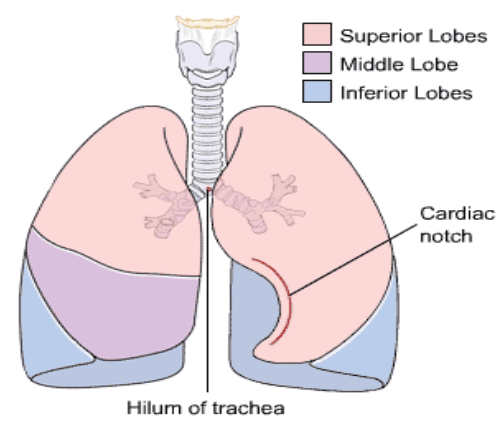Notes: Respiratory System
What is Cystic Fibrosis
Cystic fibrosis (CF) is a genetic disorder that primarily affects the lungs and digestive system. It's caused by a mutation in the CFTR gene, leading to the production of thick and sticky mucus in the lungs and other organs. This thick mucus can clog airways in the lungs, making it difficult to breathe and increasing the risk of lung infections.
Primary Functions:
1. Gas exchange
2. Production of vocal sounds
3. Sense of smell
4. Regulate blood pH
Respiration - Process of gas exchange
1. Movement of air into the lungs
2. External respiration (blood and air)
3. Gas transport in blood
4. Internal respiration (blood and body cells)
Organs of the Respiratory System
Upper Respiratory Tract - nose, sinuses, pharynx
Lower Respiratory Tract - larynx, trachea, bronchial tubes, lungs
-
Nose and Nasal Cavity: The nose is the primary entry point for air. Hairs and mucus in the nose filter and humidify incoming air, while the nasal cavity warms and moistens it.
-
Pharynx (Throat): The pharynx is a passageway for both air and food. It's divided into three parts: the nasopharynx, oropharynx, and laryngopharynx.
-
Larynx (Voice Box): Located below the pharynx, the larynx contains vocal cords that produce sound when air passes through them. Epiglottis prevents food from going into the airway.
-
Trachea (Windpipe): The trachea is a tube made of cartilage rings that connects the larynx to the bronchi. It's lined with cilia and mucus that trap particles and help to remove them from the airway.
-
Bronchi and Bronchioles: The trachea branches into two bronchi (singular: bronchus), each leading to a lung. Inside the lungs, these bronchi further divide into smaller bronchioles, conducting air deeper into the lungs.
-
Lungs: The lungs are the primary organs of respiration. They consist of lobes—three on the right and two on the left in humans. The bronchioles end in clusters of tiny air sacs called alveoli, where gas exchange occurs.
-
Diaphragm: This is a dome-shaped muscle below the lungs that contracts and relaxes to facilitate breathing. When it contracts, it flattens and increases the volume of the chest cavity, allowing air to be drawn into the lungs. Relaxation of the diaphragm causes exhalation.
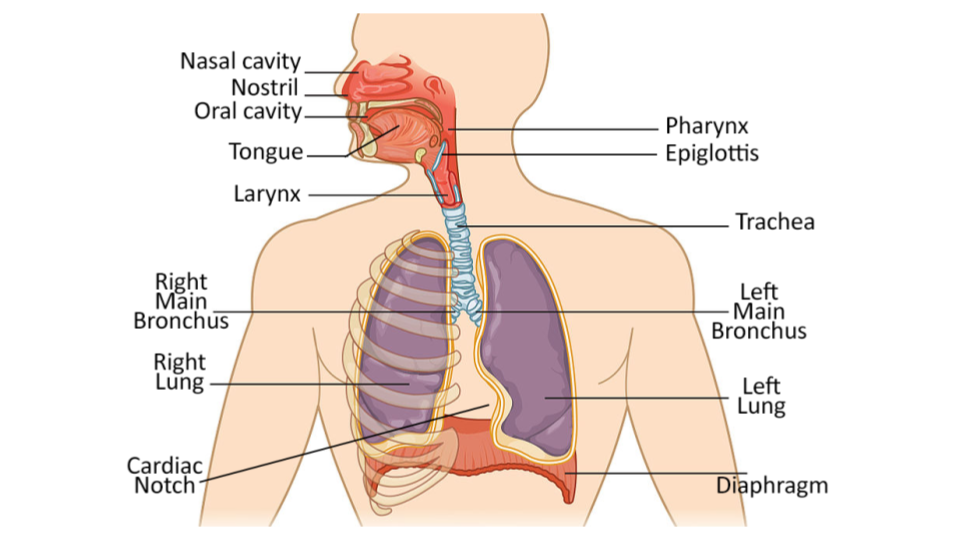
Nasal Concha - bones that divide the nasal cavity, support mucus membranes, and increase surface area
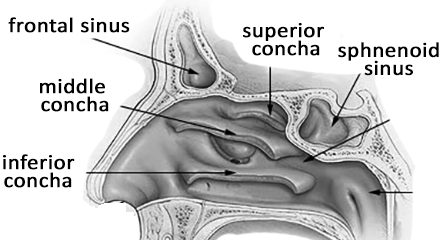
Paranasal Sinuses - spaces within the bones, reduce weight of skull, resonance (voice)
They are named after the bones (4): maxillary, frontal, ethmoid, sphenoid
Pharynx - behind the oral cavity, 3 sections:
Nasopharynx (green) || Oropharynx (blue) | Laryngopharynx (purple)
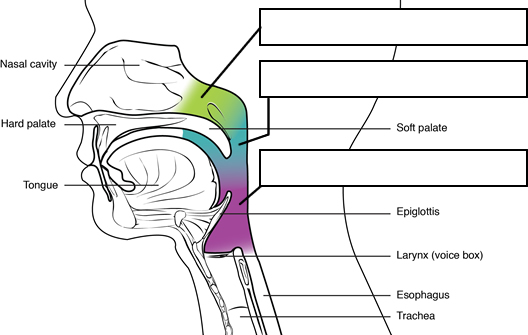
Larynx - at top of trachea, vocal cords
Glottis: part of the larynx that consists of the falso and true vocal folds
False vocal folds - close airway during swallowing
True vocal folds - produce soundEpiglottis: allows air to enter the larynx, it closes during swallowing
Laryngitis - inflammation of the vocal folds, can make speaking difficult
*Otolaryngologist - ear, nose, and throat doctor
Trachea (windpipe)
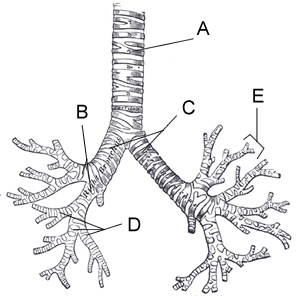
Bronchii (bronchial tubes)
Primary bronchi → secondary bronchi → tertiary bronchi → bronchiole
Bronchioles - grape shaped, contain air sacs called alveoli
Alveoli - connect to blood vessels for gas exchange
*Mucus in the alveoli in patients with CF can cause respiratory problems and infections
Lungs
- spongy tissue that sits within the pleural cavity.
Right lung = 3 lobes | Left lung = 2 lobes and a space for the heart called the cardiac notch
Serous fluid lubricates the lungs during breathing
Breathing Mechanism
1. Diaphragm moves down, forcing air into airways
2. Intercostals contract, enlarging cavity.
3. Surface tension in alveoli and surfactant keep air sacs from collapsing
4. Other muscles force a deeper breath.
5. Relaxing the diaphragm causes elastic recoil (exhalation)
Why is the first breath of a newborn the most difficult? - Air sacs are not inflated and lack surfactant
Respiratory Cycle - one inhalation and one exhalation
Inspiration - air enters the lungs | Expiration - are leaves the lungs
Diaphragm lowers and changes the pressure in the pleural cavity, causing air to enter the lungs
Model this process with a balloon and a drink bottle.
Respiratory Air Volumes - Spirometry measures the volume of air moving in and out of the lungs
Resting Tidal Volume = amount of air that enters the lungs during one cycle
Vital Capacity (lung capacity) - the amount of air that can be forced in our out by taking a deep breath
*FEV1 is the FEV volume in 1 second, used to diagnose cystic fibrosis
Atmospheric Pressure - necessary for breathing, low air pressure makes it difficult to fill lungs
Factors that Can Affect Breathing
- Rise in carbon dioxide
- Emotional upset, fear, pain
- Low blood oxygen
* Hyperventilation - increased breathing rate to lower CO2 concentration
Alveolar Gas Exchange
Respiratory Membrane - gas exchange occurs through a layer of simple squamous cells, oxygen then diffuses into blood
Hypoxia = ovreall lack of oxygen in the tissues and organs
Asphyxia = unable to breathe normally, which then causes hypoxia
Illnesses Related to the Respiratory System
1. Cystic Fibrosis
2. Chronic Obstructive Pulmonary Disease (COPD)
3. Bronchitis
4. Emphysema
5. Sleep Apnea
6. Lung Cancer
7. Altitude Sickness
8. Asthma
9. Bacterial or Viral Infections
10. Whooping Cough
Student Activities
Case Study: Tibetans and Breathing at High Altitudes
